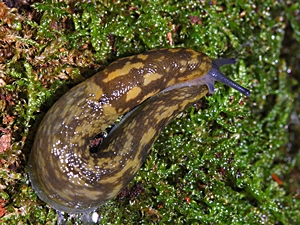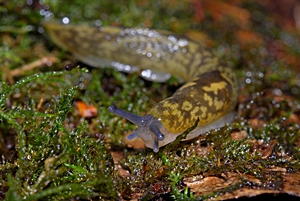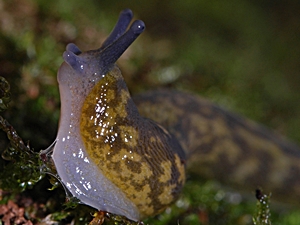
Irish yellow slug (Limacus maculatus) from Cambridgeshire,
England. Picture: Brian Eversham, (Source).
Limacus maculatus (Kaleniczenko
1851)
(Stylommatophora, Helicoidei, Limacacea, Limacidae)
 Irish yellow slug (Limacus maculatus) from Cambridgeshire, England. Picture: Brian Eversham, (Source). |
The Irish yellow slug (Limacus maculatus) is quite different from the Kerry slug (Geomalacus malaculosus), albeit for its rather similar name. The first is a keel back slug from the Limacidae family, recognizable by the keel at the end of its foot. Also its respiratory hole is located in the rear half of its mantle shield. The Kerry slug, on the other hand, is a round back slug of the Arionidae family without a keel and with the respiratory hole in the front half of the mantle shield. Both have in common their spotted exterior and their greenish colour, fitting the island they come from. But most likely on the British isles, the Irish yellow slug might be confounded with the Yellow slug (Limacus flavus).
 Irish yellow slug (Limacus maculatus) from Cambridgeshire, England. Pictures: Brian Eversham, (Source). |
|
 |
Description: Concerning its body colour, the Irish yellow slug is quite similar to the yellow slug. Usually, though, it is a bit darker and more greenish in colour. The spots dispersed over its body are irregular and may sometime melt together. Generally, the Irish yellow slug has more spots than the yellow slug and they reach further down the body sides. Where the spotty pattern is limited at the foot margin by a light coloured zone near the foot margin in a yellow slug, this light coloured zone is missing in an irish yellow slug. Between the centreline of the mantle shield and its margin, 23 wrinkles can be counted. An Irish yellow slug's mucus is greenish in colour and so are its juveniles.
Dimensions: L up to 100 mm; mantle shield 24 mm.
Habitat and Distribution: On the Crimea peninsula, in the Caucasus mountains, as well as in Bulgaria, the Irish yellow slug inhabits deciduous forests. In Northern and Central Europe, on the other hand, the species lives in natural habitats, often in woody places, below stones and fallen logs. Contrary to the yellow slug, the Irish yellow slug is not a commensal species, but prefers habitats near to nature. On the British Isles, however, Limacus maculatus is often found in the same habitats, as its relative, the yellow slug. The slugs often hide in fallen logs, often whole tree trunks are covered with mucus. The Irish yellow slug feeds on mushrooms, lichens and dead plants.
Scientists assume that the Irish yellow slug originally came from the Black Sea region (North-eastern Turkey, Caucasus, Crimea peninsula and Bulgaria). From there it has been introduced in several other parts of the former Soviet Union. Besides, the Irish yellow slug, as its name indicates, is present in Ireland, as well as in parts of Great Britain. In continental Europe, the species is expected to be found, especially in France.
Threat Situation: While the Irish yellow slug is rather common in Ireland, in Great Britain, its distribution is much more discontinuous. The species is missing in Northern Scotland, as well as in the South-west of England (Devon and Cornwall). The specimens displayed here, had been found by Brian Eversham in Swavesey, Cambridgeshire.
Systematic Remark: The Irish yellow slug can be found in literature under different synonyms. Apart from the systematic name Limacus maculatus (Kaleniczenko 1851) used here, which is also applied in Mollbase and in the Clecom list, there are also Limacus grossui Lupu 1970 and Limacus pseudoflavus Evans 1978. Evans' attempt to establish those three different species has, however, been rejected, and so the latter two names are regarded to be younger synonyms of the valid Limacus maculatus.
Besides, there is still the discussion, whether the former subgenus Limacus should have the status of a genus on its own. The Polish malacologist and slug specialist Andrzej Wiktor disagrees. In that case, the species would have to be added to the Limax genus. But then it would have to be called Limax ecarinatus Boettger 1881, becausethe systematic name Limax maculatus Nunneley 1837 is a synonym of Limax maximus, the great grey slug or leopard slug.
Links
![]() Francisco
Welter-Schultes:
Limax ecarinatus species homepage.
Francisco
Welter-Schultes:
Limax ecarinatus species homepage.
![]() Molluscs of Central
Europe:
Limacus maculatus.
Molluscs of Central
Europe:
Limacus maculatus.
![]() P. F. Whitehead:
Limax
maculatus (Kaleniczenko, 1851) (Mollusca, Limacidae) New to Worcestershire.
P. F. Whitehead:
Limax
maculatus (Kaleniczenko, 1851) (Mollusca, Limacidae) New to Worcestershire.
Literatur
![]() Wiktor, A.; Norris, A. (1982): The synonymy of
Limax maculatus (Kaleniczenko 1851) with
notes on its European distribution. - Journal of Conchology 31: 75-77.
Wiktor, A.; Norris, A. (1982): The synonymy of
Limax maculatus (Kaleniczenko 1851) with
notes on its European distribution. - Journal of Conchology 31: 75-77.
![]() Anderson, R. (2008): "An annotated list of the non-marine Mollusca of Britain and
Ireland" (PDF).
Anderson, R. (2008): "An annotated list of the non-marine Mollusca of Britain and
Ireland" (PDF).

Wildlife Trust for Bedfordshire, Cambridgeshire,
Northamptonshire and Peterborough.